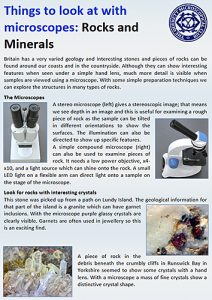Festival of Geology
Saturday 6th to Sunday 7th November 2021
** Visit the Virtual Festival of Geology website **
The Festival of Geology organised by the Geologists’ Association had to be held online again this year because of the COVID-19 epidemic and included a section for Local Groups and Societies Stalls where the Quekett and many other organisations displayed information about themselves.
Pam Hamer prepared two presentations about the geological activities of Quekett members.
Click the arrows to move through the slides. Click the symbol at bottom right for a larger version.
Click the arrows to move through the slides. Click the symbol at bottom right for a larger version.
 “Getting Started” leaflets
“Getting Started” leaflets
The Quekett has several “getting started” leaflets, including one on rocks and minerals. These small handouts are aimed at families where parents / grandparents want to encourage children to examine the ‘microworld’. Our ‘Rocks and Minerals’ handout gives a simple way for children to look at rocks and pebbles they might collect. Children are often fascinated by fossils, think dinosaurs, but the complexity of microfossils in softer rocks like limestones can easily be seen and admired with a little ‘do it yourself’ work:
- Things to look at with microscopes: Rocks and Minerals (PDF, designed to be printed and folded)
Thin section of chalcedony from Cornwall (Carel Sartory)
A 19th century preparation made by J. T. Norman of chalcedony, videoed using a motor-driven rotating polariser.
The gross specimen was imaged on a photomacrographic stand using an old Olympus OM 50 mm macro lens and a 25 mm extension tube attached to an Olympus OMD E-M10 mark II mirrorless digital camera in video mode. A linear polariser screwed into the lens acted as an analyser and the specimen was illuminated with an 8 mm diameter LED ceiling down-lighter with the motor-driven linear polariser rotating above it.
The detail was imaged using a Wild M20 microscope, a ×3 Wild Plan Fluotar objective and an Olympus NFK 2.5× photo eyepiece. The Olympus OMD E-M10 mark II was mounted on the phototube of the M20, set up for Köhler illumination. A linear polarising filter was placed in the filter holder of the objective carrier (the analyser) and the rotating polariser was placed above the illumination field lens in the base of the microscope.
Click the arrow to start the video; click the symbol to the left of “vimeo” for a larger version
Carel also made this video to show how he produces splendid images of crystals in a rock as the polariser is rotated.
Click the arrow to start the video; click the symbol to the left of “vimeo” for a larger version

